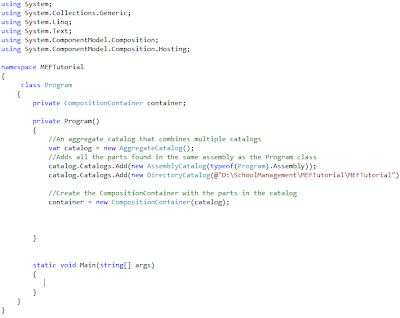1. What is Binding in WCF?
ü Simple
definition for Binding describes how the client will communicate with service.
ü Bindings
in WCF define the configuration of communication channel between clients and
services.
ü Binding
specifies
1. Transport Protocol
2. Message encoding
3. Security Mechanism
4. Reliable Messaging
5. Transactions Support
1. Transport Protocol
2. Message encoding
3. Security Mechanism
4. Reliable Messaging
5. Transactions Support
2. What are built-in bindings in WCF?
1.
BasicHttpBinding
2.
NetPeerTcpBinding
3.
WSFederationHttpBinding
4.
NetNamedPipeBinding
5.
WSHttpBinding
6.
WSDualHttpBinding
7.
NetTcpBinding
8.
NetMsmqBinding
9.
MsmqIntegrationBinding
I have used BasicHttpBinding, WSHttpBinding and NetTcpBinding
mostly.
3. How can you configure binding in WCF?
You can
configure binding either using
a.
Configuration file
b.
Programmatically using code
c.
Both
Specifications
given in configuration file are overwritten by code.
I
prefer configuring binding in configuration file. It’s easy and efficient.
4. Explain how bindings are used?
Suppose
there is a scenario where a service has to be used by two type of client.
ü One of
the client will access SOAP using http and
ü Other
client will access Binary using TCP.
In such
cases we need to configure extra endpoint in configuration file and the job is
done.
In the
configuration file common behaviors affect all endpoints globally, service
behaviors affect only service-related aspects, endpoint behaviors affect only
endpoint-related properties, and operation-level behaviors affect particular operations.
In the
service behavior below the servieMetadata node is added with attribute
httGetEnabled='true'. This attribute will specify the publication of the
service metadata. Similarly we can add more behavior to the service.
<system.serviceModel>
<services>
<service name="MathService"
behaviorConfiguration="MathServiceBehavior">
<endpoint address=""
contract="IMathService"
binding="wsHttpBinding"/>
</service>
</services>
<behaviors>
<serviceBehaviors>
<behavior
name="MathServiceBehavior">
<serviceMetadata
httpGetEnabled="True"/>
<serviceDebug
includeExceptionDetailInFaults="true" />
</behavior>
5. Does WCF support custom binding?
Yes,
bindings in WCF are completely extensible and we can create a customized one.
6. In WCf, which binding is used if you are using
WCF-to-WCF communication between processes on the same machine?
NetNamedPipesBinding
binding is used.
7. Which is binding in WCF support message streaming?
ü Following
bindings supports the streaming in WCF:
1. basicHttpBinding
2. netTcpBinding
3. netNamedPipeBinding
8. Which is binding in WCF support reliable session?
1. wsHttpBinding
2. wsDualHttpBinding
3. wsFederationHttpBinding
4. netTcpBinding











